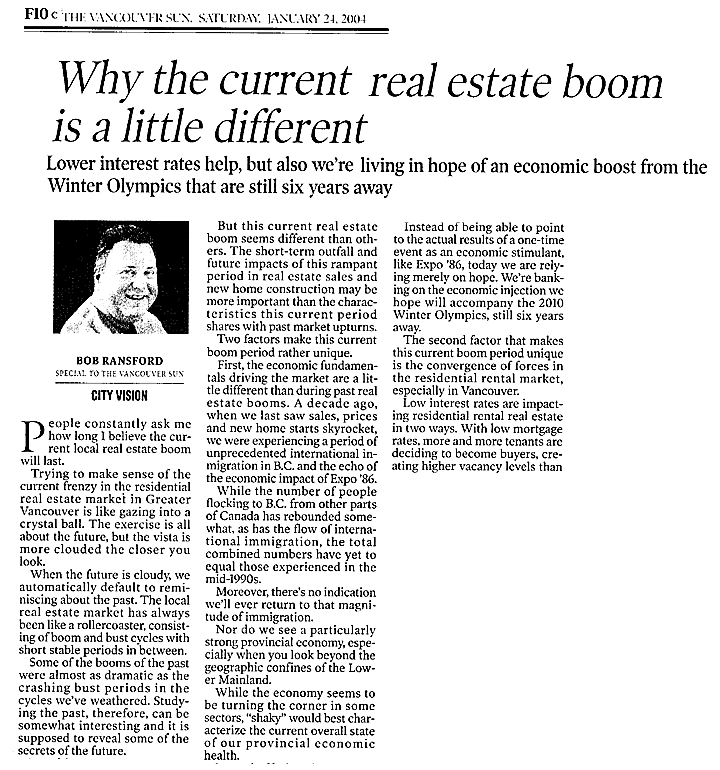Mayor expects city to surpass Vancouver’s population in a decade
Damian Inwood
Province

Construction is booming in Vancouver, B.C.’s largest city with 568,442 residents. CREDIT: Ric Ernst, The Province

Surrey is B.C.’s fastest growing city, drawing 11,972 new residents last year. CREDIT: Jon Murray, The Province

Victoria lost 600 residents last year. CREDIT: Ric Ernst, The Province
Surrey is the big winner in the B.C. population sweepstakes.
Although it didn’t notch the highest percentage increase in B.C. in 2003, the city grew by a whopping 11,972 people, or a healthy 3.2 per cent, according to B.C. Stats.
Surrey, along with the Fraser Valley communities of Maple Ridge and Abbotsford, plus the suburbs east of Vancouver, accounted for 87 per cent of growth in B.C.
“The really interesting statistic is that Vancouver is losing population at the same time as it is building all those highrises,” said David Baxter of the Urban Futures Institute. “If you take the Lower Mainland, Kelowna and then roll in Nanaimo, and Squamish-Lillooet, that’s basically B.C.’s growth. The rest is just people swapping around.”
According to figures released by B.C. Stats, Victoria and Vancouver were the two biggest losers.
Victoria‘s population dropped by 600 to 76,387, while Vancouver slumped by 365 to 568,442.
Baxter says people moving into downtown Vancouver highrise apartments are mostly kids leaving home, people upgrading from basement suites or people who’ve grown tired of shared accommodation.
“Older, single, detached areas are losing population because the kids are moving into the highrises,” he added. “It’s interesting to see emptying out of communities like Vancouver, West Vancouver, Victoria and Delta, where the population is aging.”
He said the main population growth is in places like Abbotsford, Maple Ridge, Port Moody and Surrey, where family housing is being built.
“It’s a tale of two lifestyles,” he said. “There are the urbanites in the towers downtown and the new families with kids in the new suburbs. People who want to have a Mr. Turtle pool in the back yard, and a dog, have to have it on the periphery, because the older suburbs are more expensive.”
B.C.’s population growth kept pace with the rest of Canada, growing by 31,599 to 4.15 million, a jump of .8 per cent.
The growth was third highest in Canada, behind Alberta, up 1.3 per cent and Ontario, up 1.2 per cent.
In terms of percentage, the fastest growing municipalities were Radium Hot Springs (8.1 per cent), Pemberton (7.3 per cent) and Tofino (6.2 per cent).
Radium Hot Springs residents aren’t surprised by the statistics. They’ve watched five new condominium projects go up in the last year and a half.
“A lot of it is vacation homes for people from Alberta,” said Patricia Kilback, general manager of Radium Hot Springs Lodge. “It’s a small community, very friendly, and there’s lots of work in the tourist industry.”
Baxter said Radium is part of an East Kootenay trend which sees the area becoming the playground for people from Calgary.
Pemberton’s main draw is its proximity to Whistler, according to Pemberton Community Centre employee Adam Savard.
“If you can’t live in Whistler because it’s so expensive, you come to Pemberton,” said Savard, who moved to the area two months ago from Saskatchewan.
Percentage-wise, the biggest losers were the small, resource-based communities of Chetwynd (-4.8) and Port Alice (-4.6).
“But Surrey is the big winner in terms of number of people,” he said.
“You could probably write that headline for the next five years. Surrey is so far ahead of everyone else.”
Surrey Mayor Doug McCallum, said Surrey will likely overtake Vancouver as the biggest city in B.C. in the next 10 to 15 years.
“If anything, it’s starting to accelerate,” he added. “Last year our building permits were very close to $1 billion compared to an average of $650 million. We know this year we will be over $1 billion.”
20 BIGGEST CITIES
Based on estimated 2003 population in B.C.
Vancouver 568,442
Surrey 390,145
Burnaby 205,261
Richmond 174,201
Abbotsford 127,451
Coquitlam 122,696
Saanich 107,964
Kelowna 103,421
Delta 100,571
Langley Township 91,359
North Vancouver 85,839
Kamloops 80,416
Nanaimo 76,736
Victoria 76,387
Prince George 75,609
Maple Ridge 71,399
Chilliwack 66,618
New Westminster 59,426
Port Coquitlam 57,308
N. Vancouver City 48,136
B.C.’S FASTEST GROWING CITIES
Surrey 390,145 +11,972 (+3.2%)
Abbotsford 127,451 +2,824 (+2.3%)
Maple Ridge 71,399 +2,575 (+3.7%)
New Westminster 59,426 +1,897 (+3.3%)
Kelowna 103,421 +1,713 (+1.7%)
Burnaby 205,261 +1,596 (+0.8%)
Port Coquitlam 57,308 +1,525 (+2.7%)
Coquitlam 122,696 +1,355 (+1.1%)
Courtenay 20,340 +1,104 (+5.7%)
Port Moody 26,690 +1,016 (+4.0%)
B.C.’S FASTEST SHRINKING CITIES
Victoria 76,387 -600 (-0.8%)
Vancouver 568,442 -365 (-0.1%)
Kamloops 80,416 -333 (-0.4%)
Delta 100,571 -330 (-0.3%)
Prince Rupert 14,760 -289 (-1.9%)
Oak Bay 18,207 -221 (-1.2%)
West Vancouver 42,867 -175 (-0.4%)
Quesnel 10,198 -149 (-1.4%)
Port Hardy 4,551 -148 (-3.1%)
Cranbrook 19,327 -147 (-0.8%)
— Source: BC Stats
© Copyright 2004 The Province












